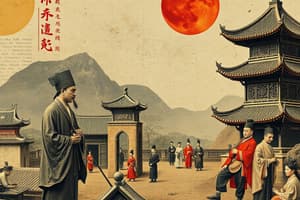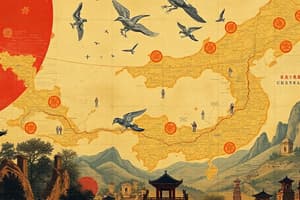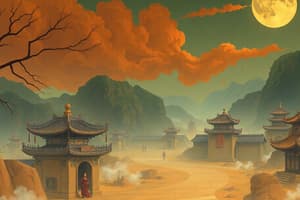Podcast
Questions and Answers
Which of the following best describes the impact of the Han dynasty's collapse on the spread of Buddhism in China?
Which of the following best describes the impact of the Han dynasty's collapse on the spread of Buddhism in China?
- The collapse had no discernible effect on the prevalence of Buddhism within the Chinese empire.
- The chaos following the collapse led many Chinese to embrace Buddhism as a 'full life' belief system. (correct)
- The stability of the Han dynasty encouraged the practical belief system of Buddhism.
- The collapse of the Han dynasty led to the immediate rejection of Buddhism in favor of Confucianism.
How did Kublai Khan's approach to governing China differ from Genghis Khan's initial strategies?
How did Kublai Khan's approach to governing China differ from Genghis Khan's initial strategies?
- Kublai Khan focused solely on military expansion, while Genghis Khan prioritized economic development.
- Kublai Khan adopted a more destructive approach to governing, while Genghis Khan sought to preserve Chinese culture.
- Kublai Khan adopted a less destructive approach to governing, recognizing the benefits of Chinese society. (correct)
- There was no significant difference; both Khans employed similarly brutal and destructive methods.
What was the primary motivation behind China's shift towards an isolationist policy during the Ming dynasty?
What was the primary motivation behind China's shift towards an isolationist policy during the Ming dynasty?
- Economic struggles.
- A fear of Mongol invasions and the desire to consolidate military power.
- A belief that China was the most civilized nation and had little to gain from outside contact. (correct)
- A desire to embrace foreign cultures and technologies without external influence.
How did Hongwu contribute to the restoration of China's greatness during the Ming dynasty?
How did Hongwu contribute to the restoration of China's greatness during the Ming dynasty?
Which of the following best describes the role of the Silk Roads during the dynasties of China?
Which of the following best describes the role of the Silk Roads during the dynasties of China?
How did the invention of movable type impact Chinese society?
How did the invention of movable type impact Chinese society?
During which dynasty did government officials typically have the best education?
During which dynasty did government officials typically have the best education?
What was the primary purpose of the magnetic compass during the Song Dynasty?
What was the primary purpose of the magnetic compass during the Song Dynasty?
What was a key characteristic of the Yuan government's attitude towards the Chinese population?
What was a key characteristic of the Yuan government's attitude towards the Chinese population?
Which of the following dynasties reunified China after centuries of civil war?
Which of the following dynasties reunified China after centuries of civil war?
Flashcards
Bureaucracy
Bureaucracy
A system of government with many departments and bureaus led by appointed officials.
Porcelain
Porcelain
A type of ceramic made of fine clay and baked at high temperatures, known for its delicacy and translucent appearance.
Reincarnation
Reincarnation
The rebirth of a soul in a new body or form.
Staple
Staple
Signup and view all the flashcards
Wendi
Wendi
Signup and view all the flashcards
Movable type
Movable type
Signup and view all the flashcards
Khanate
Khanate
Signup and view all the flashcards
Steppe
Steppe
Signup and view all the flashcards
Silk roads
Silk roads
Signup and view all the flashcards
Isolation policy
Isolation policy
Signup and view all the flashcards
Study Notes
- Dynasties of China from 581-1912
Reunification
- The Sui dynasty followed a long period of disunity.
- A famous Chinese proverb which states, "After a long union, a split will occur; after a long split, a union will occur" reflects a belief in cycles in Chinese history.
- A strong leader establishes a powerful dynasty.
- It flourishes, and then eventually declines until the people rebel and a new dynasty gains power.
- This dynastic cycle is a recurring theme in Chinese history.
- The short-lived Sui dynasty reunified China after centuries of civil war.
- The Han dynasty began its rule of China in 206 BC.
- By the 200s AD, warlords and powerful warlords caused its collapse.
- With 400 years of chaos, no single emperor ruled all of China.
- The state belief system of Confucianism declined, though its ethical ideals and Chinese culture survived.
- In 581, the dynasty cycle turned again.
- A general named Wendi seized power.
- He announced a new dynasty, called the Sui and sought to unite the region again.
- Wendi strengthened the central government, limiting the power of local nobles.
- The military was reorganized, and brought into line.
- Wendi issued a new legal code that governed relations in the border regions of the empire, encouraging popular religion. Yangdi, Wendi's son, solidified the dynasty.
- Yangdi loved luxury and built extravagant palaces.
- His useful projects, such as restoring and expanding the Grand Canal, helped restore China.
- It united China's economy, allowing Southern China's plentiful sources to flow north.
- The government and armies were located.
- Yangdi grew increasingly unpopular until, in 611, a revolt erupted.
- The dynasty ended in 618.
The Spread of Buddhism
- When bad things happen, it's common to question our beliefs and to re-examine our understanding of the world.
- Trying to make sense of the suffering, we might find comfort in the spirituality of religion- the belief that a higher power can end the misery.
- The Chinese people found comfort in religion when they needed it most.
- In troubled times, many Chinese turned to Buddhism.
- The collapse of the Han dynasty a destructive period that would last for hundreds of years.
- This troubled time, China searched for a new system related to religion, Buddhism.
- Buddhism entered China around 500 AD.
- The four Noble Truths is the cause of suffering is desire and ignorance to end. Foreign traders and missionaries brought Buddhism to China during the first century.
- Over the following centuries, Buddhim's popularity would decline.
- Buddhism continued to spread rapidly across China.
- After the chaotic period of civil war ended Confucianism made a comeback during the 600s.
- They combined Confucian ideals with nature, also adding a strong following.
Tang and Song Dynasties
- The Tang and Song dynasties arose and prospered.
- The Tang dynasty encouraged trade and cultural exchange.
- The government also strengthened the government by using civil service examinations to select scholars.
- These educated scholar-officials carried out government policy and helped the emperor to expand the dynasty.
- The Tang began expanding from central and southern Asia.
- In 960, over 50 years later, the Song dynasty emerged.
- They also introduced domestic improvements that transformed Song China.
- The Tang dynasty, in 618, helped to stabilize the empire with the Tang government.
Silk Roads
- China continued to produce goods that were popular all around the world, especially silk and porcelains.
- These trade goods helped to tie Europe, Arabia, and all lands that touched the Mediterranean Sea to the Mongol capital at Karakorum.
- Trade routes went through dangerous territories, and new routes reached north to the Mongol Empire because of tribal wars and banditry.
Life in Yuan China
- Yuan government set up strict rules to control China.
- Kublai Khan adopted a less destructive approach to governing than that of his predecessors, trying to win over the Chinese people and preserve conquered towns.
- Mongol loyalists continued to fight the Song dynasty in the south.
- In 1279, the Song dynasty was extinguished.
- Kublai Khan was now the first to all unite all China to create the Yuan Dynasty.
- His Yuan dynasty lasted until his death in 1294. The Mongols are in charge, and they discriminate against you.
- Pay higher taxes than foreigners, receive less justice, and are excluded from the best jobs-all because you're Chinese.
- Most Chinese hated living under the Mongols, who treated them as second-class citizens in their own country.
- Society was divided into four classes.
- At the very bottom of society were the southern Chinese, who made up 80 percent of the population.
- Many peasant farmers in the bottom bracket of society were forced off their land when they could not pay their taxes.
- Unable to feed their families, many sold themselves into slavery far from home.
- The Mongols feared rebellion because of the pressures they placed on the Chinese.
- Agents working for the government kept a close eye on neighbors.
- At the same time, Mongols hired people from other places to help control the region including the famous Italian merchant Marco Polo, who served as a tax collector and special envoy.
- Mongols had a strong official influence, and Kublai Khan relied on Chinese advisers.
- Most Chinese hated living under the Mongols, who treated them as second-class citizens in their own country
Travels on the Silk Roads
- Zheng He's voyages included more than 300 ships and nearly 30,000 sailors.
- He is also remembered as Explorer.
- His main mission was to glorify Yongle by asserting Chinese control over trade routes and wealthy States.
- He returned to China laden with treasure and exotic luxuries such as gold, gems, rare spices, giraffes, and zebras.
Return to Chinese Rule
- After a challenging period, the Chinese people found an unlikely rescuer in a peasant who led China's rejection.
- China's next two emperors set out to restore the country to greatness.
- The Ming dynasty's capital was a spectacular seat of power that would be used continuously for 500 years.
China Turns Inward
- An ostrich is believed to bury its head in the sand to avoid seeing its enemies, even if that doesn't stop the enemies from seeing it-or attacking it.
- China could have learned a valuable lesson on what not to do from this bird.
- Under Ming emperors, China isolated from the world.
- Forbidden City is often housed in imposing buildings that reflect imperial impressiveness.
- In 1444, rebels took over Beijing.
Chinese Inventions
- Chinese created block characters for use in movable type, a development that made it easier and cheaper to print books.
- New distribution of books helped spread ideas.
- Techniques for creating porcelain were perfect during the Tang dynasty and reached the height of artistry and perfection during the Song.
- Porcelain was a closely guarded secret. Porcelain-strong, light, and nearly see-through ceramic.
- Chinese alchemists were studying metals in gold in 110, they began use it for compass for navigation.
Legacy of Chinese Inventions
- Some Chinese improvements started around a.d 100.
- About five hundred years later, they contributed another bookmaking breakthrough: block printing.
- Around 1041, the innovation of movable type, which made it easier and cheaper to print books.
- The gunpowder was an accidental discovery.
Sui Dynasty
- Canal system- linking North and South
- Tax policies to help poor
- Military to protect people
Tang Dynasty
- Merit system
- Legal code
- Support of buddhism
Song Dynasty
- Economic prosperity
- Land reform
- Support of trade
Studying That Suits You
Use AI to generate personalized quizzes and flashcards to suit your learning preferences.




